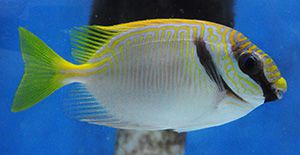Doliatus Rabbitfish
- Species Information
- Scientific Name:Siganus doliatus
- Described:doliatus rabbitfish
- Temperament:peaceful
- Maximum Size:9 inches

Siganus doliatus
The doliatus rabbitfish, Siganus doliatus (Cuvier 1830) is a stunning species that is far less common in the aquarium trade than its relatives the foxface rabbits. This beautiful fish feeds on micro and macro algae and is prized for keeping tanks clean of these nuisance species, including the often-uncontrollable Caulerpa. As are all rabbit fish, the doliatus is an active swimmer needing ample space in a home aquarium as well as liverock on which to graze and use as shelter. Because of its large size and the vast quantities of vegetation it needs to consume, nori should be added as a supplement twice daily. At the Sustainable Islands project we feed our SA Hatchery Diet, Spirulina brine, mysis shrimp, as well as gel food. Even at a small size these fish have voracious appetites. They are generally reef safe though some are known to pick at LPS coral. Maintaining well fed fish should eliminate this problem. One important fact to note is the dorsal spines of these fish are venomous so care should be taken when handling the fish or working in their tank.
Physical Description– The doliatus rabbit fish is a gorgeous fish that has captivating coloration. Its body is primarily a pale gray with yellow highlighting its face, dorsal spines, as well as its caudal fin. To contrast this yellow is an electric blue pattern that creates a unique pattern on its face, and vertical stripes down its body. Behind its eye is a black bar, intersected by electric blue. The doliatus rabbitfish is often confused with the virgate rabbit (S. virgate) but they differ in that the virgate has two of these black bars on its face.
Temperament– Like most rabbit fish, the doliatus is peaceful. It can be housed with moderately aggressive tank mates due to its venomous dorsal spines which it can use for protection. It will not bother small, peaceful fish but it may out-compete them for food. These fish will become territorial so they should not be housed together unless a pair is acquired.
Size– The doliatus can reach a maximum size of 9 inches. Because of this, and their active nature they should be housed in a 90-gallon aquarium or larger.
Diet- Because of its large size and the vast quantities of vegetation it needs to consume, nori should be added as a supplement twice daily. At the Sustainable Islands project we feed our SA Hatchery Diet, Spirulina brine, mysis shrimp, as well as gel food.
Distribution– These fish are found throughout the Western Pacific. Our specimens usually come from Fiji.







